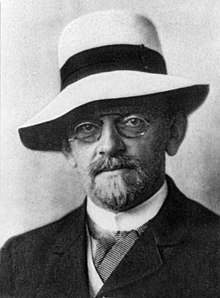فضای هیلبرت

فضای هیلبرت (به انگلیسی: Hilbert Space) که بهافتخار داویت هیلبرت نامگذاری شده، مفهوم فضای اقلیدسی را تعمیم میدهد. این فضا، روشهای جبر برداری و حسابان را از صفحه اقلیدسی دو بعدی و فضای اقلیدسی سه بعدی، به فضاهایی با هر تعداد بُعد، متناهی یا نامتناهی، گسترش میدهد. یک فضای هیلبرت، فضای برداری مجردی (به انگلیسی: abstract، انتزاعی) است که دارای ضرب داخلی بوده و اندازهگیری فاصله در آن، ممکن است. افزونبر این، فضای هیلبرت، کامل است.
فضاهای هیلبرت، بهشکل فضای بینهایتبُعدی توابع در ریاضیات و فیزیک، بسیار ظاهر میشوند. ازین نظر، نخستین فضاهای هیلبرت، دههٔ نخست قرن بیستم از سوی داویت هیلبرت، اِرهارد اشمیت و فریدیش ریس مطالعه شدند. این فضاها، ابزارهای ضروری در معادلات مشتقات جزئی، مکانیک کوانتومی، تحلیل فوریه (که شامل کاربردهای آن در پردازش سیگنال و انتقال حرارت میشود) و نظریه ارگودیک (که زیربنای ریاضی ترمودینامیک است) هستند. جان فون نویمان، عبارت «فضای هیلبرت» را در مفهومی انتزاعی، که کاربردهای گستردهای داشت، پیش نهاد.
فضاهای هیلبرت راه را برای عصر پرثمر آنالیز تابعی هموار کرد. در کنار فضاهای اقلیدسی کلاسیک، نمونههایی از فضاهای هیلبرت، شامل فضاهای توابع مربع-انتگرالپذیر، فضاهای دنبالهای، فضاهای سوبولف شامل توابع تعمیمیافته و فضاهای هاردی از توابع هولومورفیک میشود.
شهود هندسی نقش مهمی در بسیاری از جنبههای فضای هیلبرت بازی میکند. مشابههای دقیقی از قضیه فیثاغورث و قانون متوازیالأضلاع، در فضای هیلبرت نیز هستند. در نگاهی عمیقتر، تصویرکردن متعامد روی زیرفضاها (مشابه ارتفاع مثلثها) نقش مهمی در بهینهسازی و دیگر جنبههای آن، بازی میکند. در مقایسه با مختصات کارتزین در صفحه، یک عنصر از یک فضای هیلبرت را میتوان منحصربهفرد از راه مختصات و با توجه به مجموعهای از محورهای مختصات (یک پایه متعامد نرمال) مشخص کرد. وقتی مجموعهی محورها نامتناهی شمارا باشند، فضای هیلبرت را میتوان به صورت دنبالهی نامتناهی که مربع-جمع پذیر هستند تصور کرد. در قدیم، اینگونه فضاها را، فضای هیلبرت در نظر میگرفتند. عملگرهای خطی روی یک فضای هیلبرت نیز نسبتاً ملموس هستند؛ در برخی موارد، این عملگرها تبدیلات سادهای هستند که فضا را در جهتهای دوبهدو متعامد با ضریبهای متفاوت میکِشند، بهگونهایکه با مطالعه طیفشان، میتوان آنها را دقیقتر شناخت.
تاریخچه
[ویرایش]
پیشاز توسعهٔ فضاهای هیلبرت، تعمیمهای دیگری از فضاهای اقلیدسی نیز بودند که ریاضیدانان و فیزیکدانان با آنها آشنا بودند. بهویژه، ایدهٔ فضای خطی مجرد، تا پایان قرن نوزدهم، توجه ریاضیدانان را برانگیختهبود:[۱] اینها فضاهایی هستند که عناصرشان را میتوان با هم جمع کرده و اسکالرها را در آنها ضرب کرد (اسکالرهای حقیقی یا مختلط) بیاینکه لزوماً این عناصر، مفهومی بیرونی چون بردارهای «هندسی» مکان و گشتاور در فیزیک داشتهباشند. دیگر چیزهای (به انگلیسی: objects) مطالعهشده از سوی ریاضیدانان در آغاز قرن بیستم، بهویژه فضای دنبالهای (شامل سریها) و فضای توابع[۲] را میتوان فضاهای خطی در نظر گرفت. برای نمونه، میتوان توابع را با هم جمع کرده یا در اسکالر ضرب کرد، و این عملیات از قوانین جبری جمع و ضرب اسکالر بردارها پیروی میکنند.
پیشرفتهای همزمان در دهه اول قرن بیستم میلادی، به معرفی فضاهای هیلبرت انجامیدند. نخستین آنها، هنگام مطالعات داویت هیلبرت و ارهارد اشمیت در معادلات انتگرالی روی نمود[۳] و چنین بود: ضرب داخلی دو تابع حقیقی و روی بازه ، چنین تعریف میشود:
این ضرب داخلی بسیاری از خواص آشنای ضرب داخلی در فضای اقلیدسی را داراست. بهویژه، ایدهٔ توابع معامد نیز اینجا معنا پیدا میکند. اشمیت شباهت این ضرب داخلی با ضرب داخلی معمولی را بهکار گرفت تا مشابه تجزیه طیفی یک عملگر به شکل:
که در آن یک تابع پیوسته و متقارن با متغیرهای و هست را ثابت کند. نتیجهٔ کار او، بسط توابع ویژه است که تابع را بهصورت یک سری، چنین درمیآورد:
که در آن ها متعامد هستند یعنی برای تمام ها. گاهی هر کدام از جملات این سری را جوابهای ضرب ابتدایی گویند. با این حال، بسط توابع ویژهای هم یافت میشوند که بهشکل مناسبی به تابع مربع-انتگرالپذیری همگرا نباشند؛ لذا عنصر مفقوده ای که از وجود شرط همگرایی اطمینان حاصل میکند همان خاصیت کامل بودن فضاست.[۴]
جستارهای وابسته
[ویرایش]پانویس
[ویرایش]- ↑ Largely from the work of Hermann Grassmann, at the urging of August Ferdinand Möbius (Boyer & Merzbach 1991, pp. 584–586). The first modern axiomatic account of abstract vector spaces ultimately appeared in Giuseppe Peano's 1888 account ((Grattan-Guinness 2000، §5.2.2); (O'Connor و Robertson 1996)).
- ↑ A detailed account of the history of Hilbert spaces can be found in (Bourbaki 1987).
- ↑ (Schmidt 1908)
- ↑ (Titchmarsh 1946، §IX.1)
منابع
[ویرایش]- Bachman, George; Narici, Lawrence; Beckenstein, Edward (2000), Fourier and wavelet analysis, Universitext, Berlin, New York: Springer-Verlag, ISBN 978-0-387-98899-3, MR 1729490.
- Bers, Lipman; John, Fritz; Schechter, Martin (1981), Partial differential equations, American Mathematical Society, ISBN 978-0-8218-0049-2.
- Bourbaki, Nicolas (1986), Spectral theories, Elements of mathematics, Berlin: Springer-Verlag, ISBN 978-0-201-00767-1.
- Bourbaki, Nicolas (1987), Topological vector spaces, Elements of mathematics, Berlin: Springer-Verlag, ISBN 978-3-540-13627-9.
- Boyer, Carl Benjamin; Merzbach, Uta C (1991), A History of Mathematics (2nd ed.), John Wiley & Sons, Inc., ISBN 978-0-471-54397-8.
- Brenner, S.; Scott, R. L. (2005), The Mathematical Theory of Finite Element Methods (2nd ed.), Springer, ISBN 978-0-387-95451-6.
- Buttazzo, Giuseppe; Giaquinta, Mariano; Hildebrandt, Stefan (1998), One-dimensional variational problems, Oxford Lecture Series in Mathematics and its Applications, vol. 15, The Clarendon Press Oxford University Press, ISBN 978-0-19-850465-8, MR 1694383.
- Clarkson, J. A. (1936), "Uniformly convex spaces", Trans. Amer. Math. Soc., 40 (3): 396–414, doi:10.2307/1989630, JSTOR 1989630.
- Courant, Richard; Hilbert, David (1953), Methods of Mathematical Physics, Vol. I, Interscience.
- Dieudonné, Jean (1960), Foundations of Modern Analysis, Academic Press.
- Dirac, P.A.M. (1930), Principles of Quantum Mechanics, Oxford: Clarendon Press.
- Dunford, N.; Schwartz, J.T. (1958), Linear operators, Parts I and II, Wiley-Interscience.
- Duren, P. (1970), Theory of Hp-Spaces, New York: Academic Press.
- Folland, Gerald B. (2009), Fourier analysis and its application (Reprint of Wadsworth and Brooks/Cole 1992 ed.), American Mathematical Society Bookstore, ISBN 978-0-8218-4790-9.
- Folland, Gerald B. (1989), Harmonic analysis in phase space, Annals of Mathematics Studies, vol. 122, Princeton University Press, ISBN 978-0-691-08527-2.
- Fréchet, Maurice (1907), "Sur les ensembles de fonctions et les opérations linéaires", C. R. Acad. Sci. Paris, 144: 1414–1416.
- Fréchet, Maurice (1904–1907), Sur les opérations linéaires.
- Giusti, Enrico (2003), Direct Methods in the Calculus of Variations, World Scientific, ISBN 978-981-238-043-2.
- Grattan-Guinness, Ivor (2000), The search for mathematical roots, 1870–1940, Princeton Paperbacks, Princeton University Press, ISBN 978-0-691-05858-0, MR 1807717.
- Halmos, Paul (1957), Introduction to Hilbert Space and the Theory of Spectral Multiplicity, Chelsea Pub. Co
- Halmos, Paul (1982), A Hilbert Space Problem Book, Springer-Verlag, ISBN 978-0-387-90685-0.
- Hewitt, Edwin; Stromberg, Karl (1965), Real and Abstract Analysis, New York: Springer-Verlag.
- Hilbert, David; Nordheim, Lothar (Wolfgang); von Neumann, John (1927), "Über die Grundlagen der Quantenmechanik", Mathematische Annalen, 98: 1–30, doi:10.1007/BF01451579[پیوند مرده].
- Kac, Mark (1966), "Can one hear the shape of a drum?", American Mathematical Monthly, 73 (4, part 2): 1–23, doi:10.2307/2313748, JSTOR 2313748.
- Kadison, Richard V.; Ringrose, John R. (1997), Fundamentals of the theory of operator algebras. Vol. I, Graduate Studies in Mathematics, vol. 15, Providence, R.I.: American Mathematical Society, ISBN 978-0-8218-0819-1, MR 1468229.
- Kakutani, Shizuo (1939), "Some characterizations of Euclidean space", Japanese Journal of Mathematics, 16: 93–97, MR 0000895.
- Kline, Morris (1972), Mathematical thought from ancient to modern times, Volume 3 (3rd ed.), Oxford University Press (published 1990), ISBN 978-0-19-506137-6.
- Kolmogorov, Andrey; Fomin, Sergei V. (1970), Introductory Real Analysis (Revised English edition, trans. by Richard A. Silverman (1975) ed.), Dover Press, ISBN 978-0-486-61226-3.
- Krantz, Steven G. (2002), Function Theory of Several Complex Variables, Providence, R.I.: American Mathematical Society, ISBN 978-0-8218-2724-6.
- Lanczos, Cornelius (1988), Applied analysis (Reprint of 1956 Prentice-Hall ed.), Dover Publications, ISBN 978-0-486-65656-4.
- Lindenstrauss, J.; Tzafriri, L. (1971), "On the complemented subspaces problem", Israel Journal of Mathematics, 9 (2): 263–269, doi:10.1007/BF02771592, ISSN 0021-2172, MR 0276734.
- O'Connor, John J.; Robertson, Edmund F. (1996), "Abstract linear spaces", MacTutor History of Mathematics archive, University of St Andrews.
- Lebesgue, Henri (1904), Leçons sur l'intégration et la recherche des fonctions primitives, Gauthier-Villars.
- B.M. Levitan (2001) [1994], "Hilbert space", Encyclopedia of Mathematics, EMS Press.
- Marsden, Jerrold E. (1974), Elementary classical analysis, W. H. Freeman and Co., MR 0357693.
- von Neumann, John (1929), "Allgemeine Eigenwerttheorie Hermitescher Funktionaloperatoren", Mathematische Annalen, 102: 49–131, doi:10.1007/BF01782338.
- von Neumann, John (1932), "Physical Applications of the Ergodic Hypothesis", Proc Natl Acad Sci USA, 18 (3): 263–266, Bibcode:1932PNAS...18..263N, doi:10.1073/pnas.18.3.263, JSTOR 86260, PMC 1076204, PMID 16587674.
- von Neumann, John (1932), Mathematical Foundations of Quantum Mechanics, Princeton Landmarks in Mathematics, Princeton University Press (published 1996), ISBN 978-0-691-02893-4, MR 1435976.
- Prugovečki, Eduard (1981), Quantum mechanics in Hilbert space (2nd ed.), Dover (published 2006), ISBN 978-0-486-45327-9.
- Reed, Michael; Simon, Barry (1980), Functional Analysis, Methods of Modern Mathematical Physics, Academic Press, ISBN 978-0-12-585050-6.
- Reed, Michael; Simon, Barry (1975), Fourier Analysis, Self-Adjointness, Methods of Modern Mathematical Physics, Academic Press, ISBN 978-0-12-585002-5.
- Riesz, Frigyes (1907), "Sur une espèce de Géométrie analytique des systèmes de fonctions sommables", C. R. Acad. Sci. Paris, 144: 1409–1411.
- Riesz, Frigyes (1934), "Zur Theorie des Hilbertschen Raumes", Acta Sci. Math. Szeged, 7: 34–38.
- Riesz, Frigyes; Sz. -Nagy, Béla (1990), Functional analysis, Dover, ISBN 978-0-486-66289-3.
- Rudin, Walter (1973), Functional analysis, Tata MacGraw-Hill.
- Rudin, Walter (1987), Real and Complex Analysis, McGraw-Hill, ISBN 978-0-07-100276-9.
- Saks, Stanisław (2005), Theory of the integral (2nd Dover ed.), Dover, ISBN 978-0-486-44648-6; originally published Monografje Matematyczne, vol. 7, Warszawa, 1937.
- Schmidt, Erhard (1908), "Über die Auflösung linearer Gleichungen mit unendlich vielen Unbekannten", Rend. Circ. Mat. Palermo, 25: 63–77, doi:10.1007/BF03029116.
- Shubin, M. A. (1987), Pseudodifferential operators and spectral theory, Springer Series in Soviet Mathematics, Berlin, New York: Springer-Verlag, ISBN 978-3-540-13621-7, MR 0883081.
- Sobrino, Luis (1996), Elements of non-relativistic quantum mechanics, River Edge, New Jersey: World Scientific Publishing Co. Inc., Bibcode:1996lnrq.book.....S, doi:10.1142/2865, ISBN 978-981-02-2386-1, MR 1626401.
- Stewart, James (2006), Calculus: Concepts and Contexts (3rd ed.), Thomson/Brooks/Cole.
- Stein, E (1970), Singular Integrals and Differentiability Properties of Functions, Princeton Univ. Press, ISBN 978-0-691-08079-6.
- Stein, Elias; Weiss, Guido (1971), Introduction to Fourier Analysis on Euclidean Spaces, Princeton, N.J.: Princeton University Press, ISBN 978-0-691-08078-9.
- Streater, Ray; Wightman, Arthur (1964), PCT, Spin and Statistics and All That, W. A. Benjamin, Inc.
- Teschl, Gerald (2009). Mathematical Methods in Quantum Mechanics; With Applications to Schrödinger Operators. Providence: American Mathematical Society. ISBN 978-0-8218-4660-5..
- Titchmarsh, Edward Charles (1946), Eigenfunction expansions, part 1, Oxford University: Clarendon Press.
- Trèves, François (1967), Topological Vector Spaces, Distributions and Kernels, Academic Press.
- Warner, Frank (1983), Foundations of Differentiable Manifolds and Lie Groups, Berlin, New York: Springer-Verlag, ISBN 978-0-387-90894-6.
- Weidmann, Joachim (1980), Linear operators in Hilbert spaces, Graduate Texts in Mathematics, vol. 68, Berlin, New York: Springer-Verlag, ISBN 978-0-387-90427-6, MR 0566954.
- Weyl, Hermann (1931), The Theory of Groups and Quantum Mechanics (English 1950 ed.), Dover Press, ISBN 978-0-486-60269-1.
- Young, Nicholas (1988), An introduction to Hilbert space, Cambridge University Press, ISBN 978-0-521-33071-8, Zbl 0645.46024.
آنالیز تابعی (موضوعات – واژهنامه) | |||||
|---|---|---|---|---|---|
| فضاها |
| ||||
| قضایا |
| ||||
| عملگرها |
| ||||
| جبرها |
| ||||
| مسائل باز |
| ||||
| کاربردها |
| ||||
| موضوعات پیشرفته |
| ||||
| شاخهها | |
|---|---|
| ساختارهای جبری |
|
| جبر خطی | |
| جبر چندخطی |
|
| لیست موضوعات |
|
| واژه نامهها |
|
| مباحث مرتبط |
|
فضاهای برداری توپولوژیکی (TVS ها) | |
|---|---|
| مفاهیم پایهای |
|
| نتایج اصلی |
|
| نگاشتها |
|
| انواع مجموعهها |
|
| عملیات مجموعهها |
|
| انواع TVSها |
|
Text is available under the CC BY-SA 4.0 license; additional terms may apply.
Images, videos and audio are available under their respective licenses.


![{\displaystyle [a,b]}](https://wikimedia.org/api/rest_v1/media/math/render/svg/9c4b788fc5c637e26ee98b45f89a5c08c85f7935)









